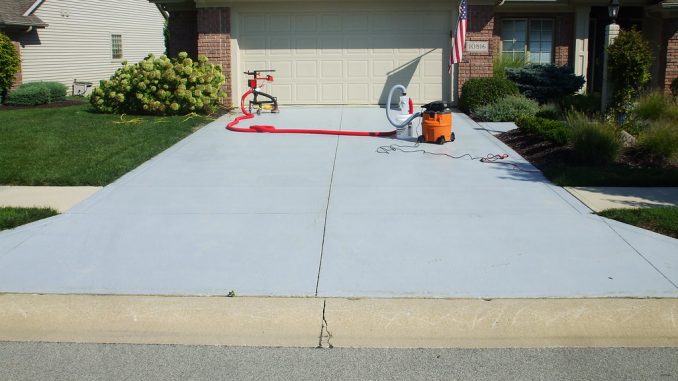
Did you know, globally, millions of homeowners face driveway repair issues each year, yet a staggering percentage inadvertently make matters worse due to common blunders?
Welcome to our enlightening journey through the “9 Common Driveway Repair Mistakes” that homeowners make. This isn’t just about fixing a driveway; it’s about empowering you with knowledge and insight, transforming you from an everyday homeowner into a savvy, driveway-repairing maven.
- Ignoring Small Cracks
Firstly, overlooking those tiny cracks? Big mistake. Think of small cracks like a tiny window left open in a storm; they might seem insignificant at first, but soon enough, they let in a deluge of problems. These seemingly minor fissures can widen, leading to major repairs down the line.
The lesson here is simple: act fast. Treat those small cracks as a priority in your driveway repair. Fill them promptly to prevent water infiltration and subsequent damage. It’s a quick fix today that saves a major headache tomorrow. Addressing small issues promptly is not just smart; it’s cost-effective.
- Choosing Low-Quality Materials
Bargain-hunting for repair materials might feel like a win, but trust me, it’s a false economy. Low-quality materials may save you a few bucks upfront, but they’ll cost you more in the long run. Inferior materials, such as subpar sand and soil, degrade faster, meaning more frequent repairs and higher costs over time.
Investing in high-quality repair materials is investing in the longevity of your driveway. For example, using premium-grade sand and soil can significantly improve the durability of your repairs. Don’t skimp on quality. Choose materials that withstand the test of time and weather. It’s not just about the repair; it’s about the legacy of a driveway that stands strong and resilient.
- Poor Preparation
Preparation is key, and cutting corners here is like setting sail without a compass. Failing to properly clean and prepare the surface before beginning repairs can lead to subpar results. It’s like painting over a dirty wall; the end result just won’t hold up.
The trick is in the thoroughness. Ensure the surface is clean, dry, and free of debris before starting any repair work. This might take a bit more time, but it’s time well spent. A well-prepared surface ensures repairs that are not just cosmetic but durable and long-lasting.
- Incorrect Application Techniques
Now, let’s talk technique. Applying repair materials incorrectly is like trying to fit a square peg into a round hole – it just won’t work. Incorrect application can lead to uneven surfaces, poor adhesion, and ultimately, a repair job that needs redoing.
Educate yourself on the correct application techniques for the materials you’re using. Whether it’s spreading, smoothing, or sealing, doing it right makes all the difference. Remember, a job worth doing is worth doing well.
- Overlooking Weather Conditions
Ignoring the weather forecast? Big no-no. Repairing your driveway under unsuitable weather conditions is akin to painting in the rain. Too hot, too cold, or wet weather can sabotage your repair efforts, causing materials to not set properly.
Always check the weather forecast before starting your repair work. Ideal conditions ensure the materials set correctly and last longer. Timing is everything – make sure Mother Nature is on your side when you embark on your driveway repair project.
- Inadequate Compaction
Compaction is not just a step; it’s a cornerstone of driveway repair. Neglecting to properly compact the repair area is like building a house on sand; it won’t hold up. Inadequate compaction leads to a weak repair that will likely need redoing sooner rather than later.
Take the time to compact the repair area thoroughly. This ensures a solid, stable foundation for your repairs, extending the life of your driveway. It’s an extra step that makes a world of difference in durability.
- Improper Sealing
Sealing is the final, crucial step in driveway repair, and overlooking it is akin to leaving a job half done. An improperly sealed driveway is vulnerable to water, UV rays, and other environmental elements, leading to quicker deterioration.
Ensure your driveway is properly sealed after repairs. This not only protects the repair work but also extends the overall life of your driveway. It’s the finishing touch that shields your hard work from the elements.
- Doing It Alone When Expert Help is Needed
Sometimes, the DIY approach isn’t the best approach. Tackling complex repairs without the necessary skills or experience can lead to subpar results or even further damage. It’s like performing surgery on yourself – not advisable.
Know when to call in the professionals. For complex repairs, hiring an expert can save you time, money, and a lot of headaches. It’s about recognizing your limits and valuing the expertise that professionals bring to the table.
- Ignoring Local Regulations and Standards
Last but not least, local regulations and standards are not just red tape; they’re guidelines for safety and quality. Ignoring them can lead to legal troubles and potentially unsafe conditions. It’s like ignoring road signs; you might get lost or even end up in danger.
Always check and adhere to local regulations and standards for driveway repair. This ensures your repair work is not just up to par, but safe and compliant. It’s about being a responsible homeowner who values not just their property, but also their community and its guidelines.
Takeaways
There you have it – the “9 Common Driveway Repair Mistakes” laid out in all their glory. Remember, repairing your driveway is more than just a chore; it’s an opportunity to add value and longevity to your home. By avoiding these common pitfalls, you’re not just fixing a driveway; you’re mastering the art of home maintenance.
So go ahead, tackle your driveway repairs with confidence and savvy. Your driveway – and your bank account – will thank you for it.

Be the first to comment